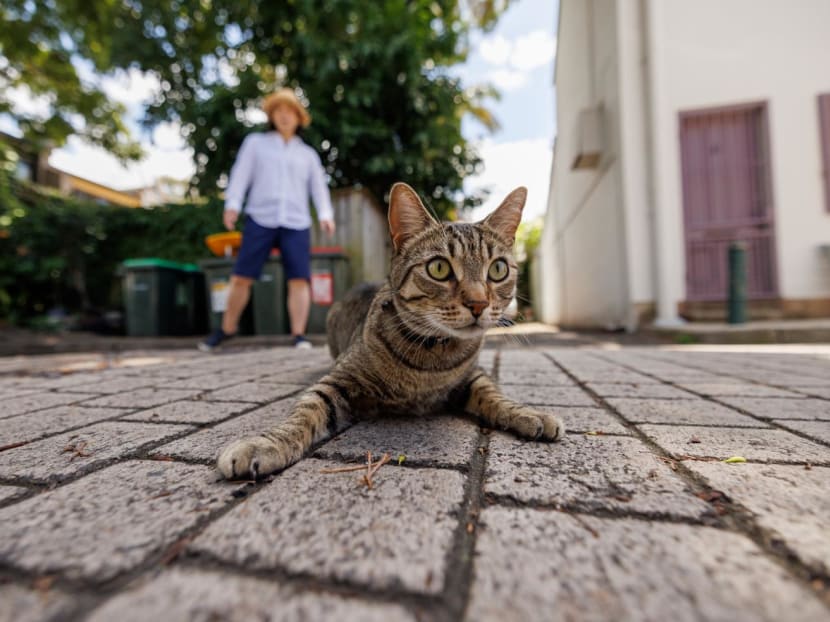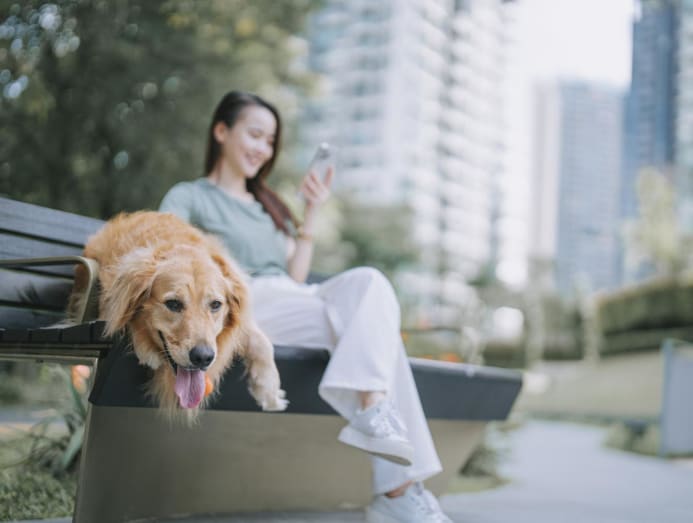8 pet trackers in Singapore to prevent your furry friends from going missing
AirTags may work, but GPS trackers cover more ground. Here are eight devices that will help pet owners in Singapore avert a crisis.

(iStock/SteveLuker)
When pets go missing, a quick Google search suggests alerting the Animal Response Centre (ARC) and the Society for the Prevention of Cruelty to Animals (SPCA), before plastering notices all over your neighbourhood.
But other than keeping their fingers crossed, pet owners have woefully few options.
This is where trackers come in. While not all trackers are made to intercept furry escape artists, one Airtag apparently reunited Tiktok user @osrastays with her cat, Tofu. When he was found, the champ had covered nearly 9km between Geylang and Marina South pier on his paws.
The video went viral across the world, garnering millions of views and thousands of comments, where fellow pet owners recommended trackers that have helped them avert a crisis or two. While not all of them work in Singapore, we’ve rounded up the ones that do lest your dog or cat follow in Tofu’s footsteps.

BLUETOOTH TRACKERS
Most item finders, which are attached to personal belongings, are powered by Bluetooth. They’ve helped to find keys, purses, and even suitcases lost in transit, but we suppose nothing can stop you from putting one on your dog’s or cat’s collar.
Bluetooth trackers have long battery lives and tend to be lightweight and affordable. However, most cover a limited range, exceeding which you would have to count on similar devices near your lost possession.
Let’s take Tofu’s Apple AirTag for example. It weighs 11g, lasts more than a year on a standard battery, and has water-resistant properties. Importantly, it works by emitting a signal, which then gets picked up by Apple users in the vicinity. They acted as crowdsourced “beacons” and sent Tofu’s location to iCloud, and the rest is history. Who would’ve guessed that a S$45.49 device can single-handedly put Tofu’s family out of distress?
Of course, an Apple product does not simply exist without an Android counterpart – the Samsung Galaxy SmartTag. In place of Apple devices and iCloud, it relies on Galaxy phones and the Galaxy Find Network. It costs approximately S$35 but has a shorter battery life of 165 days. Both trackers use Ultra Wideband connectivity to guide you towards your lost pet intuitively, and neither will burn a hole in your wallet.
RADIOFREQUENCY TRACKERS
Like Bluetooth trackers, radio frequency trackers are lightweight and have long battery lives. But, unlike them, they do not rely on cellular networks and can only clock lost pets within a fixed range.
Now, this isn’t objectively a deal breaker. If your cat is more territorial than free-roaming, it may not veer far from home. Still, they can get into trouble in elusive corners. Perhaps they’ve been stranded on a tree, trapped in a neighbour’s garden, or terrorised by stray dogs into hiding. If that sounds like your kitty, a radio frequency tracker may suffice.
Tabcat, a product developed in the UK, is a fine example. At S$120, it almost triples the price of Bluetooth trackers but claims to trump them in range and performance. It tracks up to four cats within 182m and each one weighs only 5g, making it perfect for that new litter of kittens. Whether they’re indoors or outdoors, your directional handset will tell you where to walk through a series of beeps and lights.
Interestingly, Tabcat even doubles up as a “pager”. According to their website, nearly 70 per cent of users managed to summon their cat to come home by pressing a small button which activates a small beep on their tag. You may need to bribe them with treats for a start, but still.
GPS TRACKERS
GPS trackers are the most evolved of the lot. Compared to radio frequency trackers and Bluetooth trackers, they cover a large – if not unlimited – range, which bodes well for dog owners. Plus, they rely on satellite systems and, at times, cellular networks instead of nearby devices. So, even if your dog winds up in the recesses of Tuas where civilisation does not reach, there’s a good chance you can find it.
Below are some options:
PETFON
If you have an escape artist on your hands, you’ll rest your case with Petfon's Petfon2 (S$245). The water- and dust-resistant tracker covers up to 1km and 6.5km in dense and open areas respectively, lasting nine to 17 hours on a single charge. The geofencing function allows you to designate a “safe” zone and get notified when your good boy crosses the line, and you can even communicate remotely via pre-recorded voice commands if need be.
But the Petfon2 provides more than real-time location updates. The 27.6g tracker – the approximate weight of an AA battery – is something of a fitness tracker, too.
The app tells you for how long your dog has been sedentary or active, as well as the distance covered in feet and, rightfully, paws walked. Since it does not rely on cellular networks and instead combines GPS, Bluetooth, and Low Power, Wide Area Network (LoPoWan) technologies, you needn’t pay a monthly subscription fee. The value you’re getting goes beyond.
FINDSTER
Findster may be a better match for pet owners who are after value for money. It enables real-time GPS tracking and geofencing, like PetFon2, but differs in price, range, and weight. For a price of approximately S$200, it covers a smaller range of 0.8km to 4.8km in dense and open areas respectively.
The 21g tracker packs a punch with water- and shock-proof properties, claiming to be “tougher than your old Nokia 3310”.
On top of safe zones, Findster also lets you mark out danger zones, like your neighbour’s house, and keep your pet close on a virtual leash. Multiple family members can track up to three pets, with leaderboards indicating the fastest runner among them. The most useful feature, however, is a battery that adapts to your needs. It lasts between three and seven days, depending on whether the GPS and/or activity-tracking functions are activated.
TRACTIVE
Tractive, a GPS tracker made for both dogs and cats, promises an unlimited range for approximately S$70. The catch? A monthly subscription adds up to roughly S$137 a year.
From the looks of it, Tractive appeals to those who would pull out all the stops for their furry companion’s longevity. Apart from live location updates, virtual fencing, and activity tracking, you can keep tabs on calories burnt, hours slept, and even mid-slumber interruptions. This data can be benchmarked against that of other dogs like them, so red flags of their wellbeing can be clocked in good time.
The battery lasts up to seven days on a single charge, which takes two hours, but goes into power-saving mode whenever your home WiFi network is detected. Tractive weighs 35g and is suitable for dogs and cats as light as 4kg.
TACK
While Tack was first invented in Singapore to help caregivers keep their loved ones, it also works on pets, luggage, and vehicles. For S$79 and a monthly subscription that costs approximately S$4.40 a year, it combines the prowess of GPS, WiFi, and IoT mobile networks in a 30g device with tracks with the precision of, well, a tack.
To call Tack reliable would be an understatement. The device can withstand all weather and terrain conditions, create as many as four safe zones, and last 30 days on a single charge. The battery life is so impressive because Tack uses artificial intelligence, smart sensors, and low-power components to optimise power usage. In layman’s terms, it “pro-rates” the power used based on your pet’s lifestyle and your preferred frequency of location updates.
PAWTRACK
Pawtrack is your guy if you want a device that is optimised for cats through and through. Since its launch in 2012 as a Kickstarter project, the cat-tracking collar has been through several iterations, shrinking in size and expanding its suite of feline-specific features each time. It comes in three adjustable sizes and costs approximately S$47 and S$80 for the device and annual subscription respectively.
Real-time location updates, geofencing, and multi-cat tracking are the bare minimum for Pawtrack, which claims to have introduced the world’s first flexible antenna. Rather than being tucked under your cat’s chin, it faces upwards to the sky and combines four levels of technology – GPS, LTE-M, WiFi, and cellular networks – for the best chance of an accurate signal.
The app also shows your cat’s location history and heatmap, so you would be privy to its secret rendezvous while you’re out.
There are a few things to note: PetFon and Findster, which combine radiofrequency and GPS technologies, cover a large but not unlimited range, and therefore require only a one-time payment.
Meanwhile, Tractive, Tack and Pawtrack are GPS trackers through and through that cover an unlimited range. The catch? You’d have to pay for a monthly or annual subscription on top of the device.










